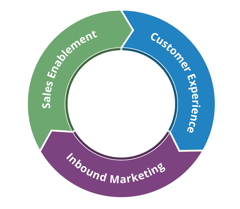To reach your revenue goals, it is essential to understand your baseline marketing and sales metrics so you can determine how much growth you need in each area of your marketing and sales program. By analyzing your current marketing and sales numbers, you can also make sure your goals are realistic yet attainable. These are called SMART goals, which means Specific, Measurable, Attainable, Relevant, and Time-bound. The following 4-part process will help you set your initial goals for an inbound marketing campaign. This process aligns your bigger picture marketing objective with smaller metrics that work together to meet your overall goal.
- Start with your target revenue number. The ultimate goal of any marketing program is generally to drive revenue. With that in mind, you need to start backward with your primary revenue goal to determine the other key metrics that will roll up into that primary metric.
- Determine your lead-to-customer conversion rate. This is your typical conversion rate of how often a prospect becomes a customer in your pipeline.
- Identify how many leads you need to generate to reach your customer goal based on your lead-to-customer conversion ratio. This will help you determine how many new contacts need to be added to the database to convert into customers.
- Understand your visitor-to-lead conversion rate. This is how many people visit your website and submit their contact information to request more information or join your database.
It’s essential to start with your end goal and work backward. Always focus on your most critical number first. Then all the integrated strategies of your marketing program will help you attain that end goal. Here is an example of what your numeric goals may look like, and how you can turn your goals into actionable metrics. You should consider making a conservative and optimistic goal, so you have a range of metrics for each goal.
 Next, identify even more defined micro metrics that will also align with your SMART goals. These could be any of the following marketing tactics, and many more:
Next, identify even more defined micro metrics that will also align with your SMART goals. These could be any of the following marketing tactics, and many more:
- Number of Social Posts Per Month
- Number of New Blog Posts Per Month
- Number of Email Campaigns to Your Database Per Month
- Number of New Downloadable Content Pieces Per Month
There is no limit to how many goals you can set, but make sure they all align back to your SMART goals, so you are working on the right priorities to help you achieve your marketing and business objectives. Remember, you may not have all this information at first, but once you start tracking these metrics, it will become much easier to track your progress over time. Tracking your progress will make identifying your SMART goals for each of your campaigns easier over time, and it will become part of your overall marketing planning and strategy process.
Are you looking for ways to optimize your inbound strategy? The book "Mastering Inbound Marketing: Your Complete Guide to Building a Results-Driven Inbound Strategy," written by Elyse Flynn Meyer, Owner & Founder of Prism Global Marketing Solutions, covers every aspect of the inbound marketing methodology, including the revenue generation trifecta of marketing, sales, and the customer experience. Check out the book to see how to most efficiently and effectively develop, implement, and maintain your inbound marketing strategy.


__Square.png?width=250&height=250&name=Marketing_Hub_(1)__Square.png)




.png?width=250&name=diamond-badge-color%20(1).png)
